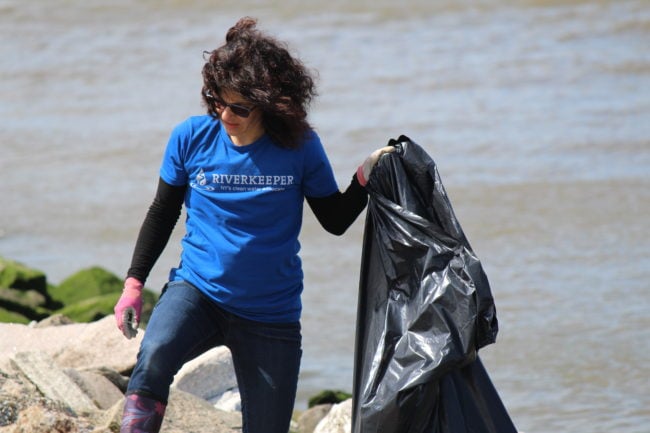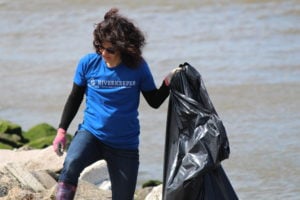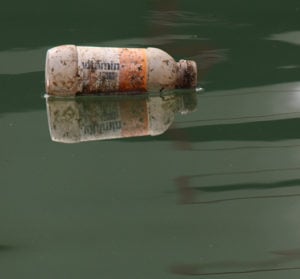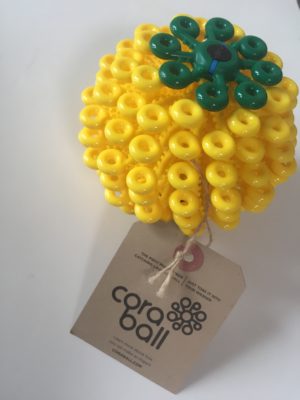5 things you can do to reduce plastic pollution (& they’re not hard at all)

View more images on our Flickr site
The amount of plastic pollution in our environment is absurd. We’re learning more about just how much plastic circulates in the water, how much is being ingested by marine life, and what the effects are. Earth Week is a good time to establish new habits. As a reminder, here are a few ways you can help turn this problem around.
 1. Clean your shoreline. Once you’ve spent a few hours picking plastic bottles and bottle caps up off the beach, and pulling chip bags out of the brush, you’ll never look at plastic the same way again. You’ll immediately feel like you’ve made a difference for your local shoreline. You can make an enormous, visible difference to the Hudson in just a day if you’re part of Riverkeeper Sweep each year in early May.
1. Clean your shoreline. Once you’ve spent a few hours picking plastic bottles and bottle caps up off the beach, and pulling chip bags out of the brush, you’ll never look at plastic the same way again. You’ll immediately feel like you’ve made a difference for your local shoreline. You can make an enormous, visible difference to the Hudson in just a day if you’re part of Riverkeeper Sweep each year in early May.
Or, you can join clean up projects with our community-based groups throughout the year.
 2. Expand New York’s bottle bill. Plastic bottles were the most common type of litter found along the Hudson in Riverkeeper Sweep shoreline cleanups in 2019. Expanding New York’s 5-cent deposit on containers is a critical policy solution to address both plastic pollution and the current recycling crisis. Please send a message to Governor Cuomo and your state representatives, urging them to support Assemblymember Englebright’s A.5028-A, which would expand New York State’s bottle deposit program to include non-carbonated beverages as well as wine and liquor glass bottles.
2. Expand New York’s bottle bill. Plastic bottles were the most common type of litter found along the Hudson in Riverkeeper Sweep shoreline cleanups in 2019. Expanding New York’s 5-cent deposit on containers is a critical policy solution to address both plastic pollution and the current recycling crisis. Please send a message to Governor Cuomo and your state representatives, urging them to support Assemblymember Englebright’s A.5028-A, which would expand New York State’s bottle deposit program to include non-carbonated beverages as well as wine and liquor glass bottles.
3. Skip straws. Like plastic bags, plastic straws are among the top 10 items of trash found in U.S. waters, and they’re generally not recyclable. Restaurants can be convinced to forgo the straws and stirrers unless customers request them. They can offer paper straws, as McDonald’s is starting to do.
New Paltz, at the urging of high school students and with information from Riverkeeper, has decided to ask the local restaurants to get on board. See the local resolution passed by the Town and Village of New Paltz this month and take it to your own town hall. The Last Plastic Straw has a standard pledge form that restaurants can use, and cards that patrons can leave with their bill.
4. Bottle your own. If you need more convincing to avoid bottled water, take a look at our updated list of reasons. Bottled water might seem cleaner, but the federal government requires far more rigorous and frequent safety testing and monitoring of municipal drinking water than of bottled water.
Despite having world-class tap water in NYC, New Yorkers purchase and consume over a billion bottles of water yearly – about 125 bottles for every man, woman and child. About 86 percent of empty plastic water bottles in the United States land in the garbage instead of being recycled. Learn more and spread the word.
 5. Mind your microfibers. Just like plastic microbeads in cosmetic products, microfibers from our clothing can pass through wastewater treatment plants into our waterways. A nationwide ban is targeting the microbead problem, but microfibers? Follow the research on this problem and some possible solutions. Our friends at the Rozalia project developed the Cora ball, designed to catch fibers in the laundry. You can be among the first to try it out.
5. Mind your microfibers. Just like plastic microbeads in cosmetic products, microfibers from our clothing can pass through wastewater treatment plants into our waterways. A nationwide ban is targeting the microbead problem, but microfibers? Follow the research on this problem and some possible solutions. Our friends at the Rozalia project developed the Cora ball, designed to catch fibers in the laundry. You can be among the first to try it out.
Riverkeeper is supporting science research on microplastics in the Hudson River Estuary, and we want to learn much more about how they affect marine life. In a pilot study last summer, researchers from Lamont-Doherty Earth Observatory took water samples from the Riverkeeper patrol boat and confirmed that indeed, New York’s Waterways Are Swimming in Plastic Microbeads.
Looking at the microscopic bits of plastics, Lamont found that “many appeared to be eroded bits and fibers of larger items—remains of carpets, clothing, food packaging, paints — but among them were also apparent microbeads. Plastics from Newtown Creek carried heavy doses of atlenol, a drug used to treat high blood pressure.”
In another Lamont study, students found plastics in the guts of common marine organisms from around the world, including those sold at local fish markets. They found microbeads in small fish from Piermont Marsh, oysters from the New York harbor vicinity, commercial shrimp from South America, and clams from China.
The news is truly sickening – and we’ll keep learning more. Meanwhile, let’s do what we can.
Read more at our Trash Free Hudson page.
